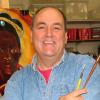"Food Program in Guatemala" by Oblate of St. Francis de Sales Br. Mickey McGrath (Mickey McGrath)
I was blessed in 2017 with a life-changing opportunity to travel to Guatemala with Catholic Relief Services and do nothing but sketch. I was only there for one week with a handful of other American observers, but what a life changing week it was. Our primary mission was to visit schools and other CRS-sponsored programs dedicated to education, but we also visited other sites and facilities such as the one depicted above in the drought-stricken and dusty hills of Quiche, home to Mayan Indians in the mountainous region of central Guatemala.
I couldn't wait to sketch the mothers, many with babies wrapped in colorfully woven blankets, as they explained to us their struggles in the midst of drought and devastation. It was dusty and dry with no evidence of green vegetation of any kind, yet colorful balloons hung above our heads to celebrate our visit in a sign of their joyful welcome.
The woman on whose land we gathered opened with a lovely prayer in praise and thanks to God for the Earth. I later learned that Guatemalan farmers thank Mother Earth and ask her forgiveness before digging into the soil with their shovels and pickaxes. Meanwhile, in full view on a neighboring hillside was the rather ostentatious mansion of a local drug lord, which did not inspire me to draw even the littlest of thumbnail sketches.
Earth is the lovingly maternal, beautifully feminine, life-giving evidence of our living, breathing God. And yet over time we have consistently missed that message and are now paying the price.
My visit to Guatemala and all the "terrible beauty" (to borrow a phrase from Irish poet William Butler Yeats) I witnessed there have contributed to my ever-evolving awareness of Mother Earth and all of creation as gifts from God which we are meant to work with and nurture, not exploit and plunder. Earth is the lovingly maternal, beautifully feminine, life-giving evidence of our living, breathing God. And yet over time we have consistently missed that message and are now paying the price.
Since that visit to Guatemala, and maybe even because of it, I have come to take a fresh look at our concept of the Earth as humanity's common mother and home. And some of my favorite women saints from across times and cultures have stepped up and have inspired me with new levels of awareness and understanding.
Three of them are depicted standing beneath a tree in my recent drawing of Brigid of Ireland, Hildegard of Bingen and Kateri Tekakwitha; each of them was firmly rooted to the Earth while their spirits soared to the heavens.

"Sisters of the Earth" by Br. Mickey McGrath (Mickey McGrath)
The Indigenous people of Ireland, the Celts, were passionate in their love and respect for their very green homeland. And since the Romans never quite made it across the Irish Sea from Britain when they were conquering the rest of Europe, the Celts were able to preserve and maintain their unique cultural identity free of Roman interference — whether it be from the Empire or the church — until they couldn't.
Sts. Brigid, Patrick and Columcille, who are called the Irish Holy Trinity, each lived in these earlier, more free-spirited times wherein all of creation and her creatures were much clearer proofs of God's presence in our midst than all the later doctrines and dogmas combined.
A wild goose stands at Brigid's feet in my drawing because in the early days of Irish Christianity, the Holy Spirit was symbolized as a goose, not a dove. Brigid's close identification with nature was evidenced in the many stories and legends of her life involving her connection to creatures. She had a miraculous cow that never stopped giving milk to feed people in times of famine; she domesticated a fox and gave it to a chieftain whose own beloved pet fox had been killed by a peasant farmer.
Brigid also said that we should all see ourselves as midwives, male or female, whose job it is to give birth to Christ over and over again in our present world. Through us, Christ is eternally incarnate when we work together and make deep connections to each other, to all creatures and to Mother Earth herself.
Later in the Middle Ages, Irish monks and mystics found their way onto the continent where they opened schools and monasteries or sometimes lived alone in hermitages. One of them, St. Disibod, became a natural remedies healer in Germany whose simple garden hermitage eventually became the site of a Benedictine monastery where Hildegard of Bingen began her brilliant career as a mystic and Doctor of the Church. She even wrote a biography of him because of his importance in her own spiritual development.
"St. Hildegard's Green Holy Spirit" by Br. Mickey McGrath (Mickey McGrath)
Hildegard, a Benedictine nun and "mere woman" (her words), possessed one of the most brilliant and creative minds in all of church history. She was a visionary who traveled up and down the Rhine River preaching the Word and fearlessly challenged popes, priests and emperors — not always successfully — to loosen their grips on power and privilege and come to Jesus. Perhaps the influence of her beloved Irish St. Disibod taught her about Brigid's strong maternal spirit.
Hildegard worked with nature, not against it, and spoke out against human exploitation and destruction of the Earth. She once said, "Human beings are the thinking heart of the universe called to be co-creators with God in shaping the world." I think she would have got along famously with Jesuit Fr. Pierre Teilhard de Chardin in our own times because, like him, she felt that God's Sacred Heart pulses throughout the universe, from the depths of the Rhine to the farthest stars.
Hildegard taught that the Holy Spirit is green, as seen here in the green tinted dove she holds in her hands. Green is the color of newly emerging life in spring and the abundant vibrancy of summer. It is the color of Irish hills and German river banks. We can enjoy heaven right here on Earth, St. Hildegard said, if we can remain sensitive to the Earth's green freshness. She even coined a word for it: viriditas. A thousand years later, we need that same spirit of viriditas more than ever, just as we need Hildegard's celebration of the maternal, feminine, life-giving side of God.

"St. Kateri Tekakwitha" by Br. Mickey McGrath (Mickey McGrath)
Pope Benedict canonized Kateri Tekakwitha in 2012, the same year he officially canonized Hildegard of Bingen and named her a Doctor of the Church. Kateri is now a patron saint of ecology and the environment along with Francis of Assisi.
Mohawk on her father's side and Algonquin on her mother's, Kateri embodied all the spiritual depth and awareness that comes with Indigenous cultures around the world. Born in what is now New York state, she was only 24 years old when she died outside what is now Montreal, Canada. She had lots of mystical life experience and many challenges in those two short decades. For Kateri, as for all Native people, creation and creatures lead us to the Creator, the Great Spirit, the God who is both divine father and mother at the same time.
Born into the Turtle Clan of the Mohawks, Kateri knew the tricky balancing act of being equally at home in the physical, masculine world of land and the feminine, spiritual realm of water. The Jesuit missionaries who knew her well reported that she loved to retreat into the woods every afternoon and prayed beneath a white oak tree that is still alive and well today. (You can view that tree in the woods behind her shrine in Fonda, New York.) And Kateri equally loved to meditate before the Blessed Sacrament in the various mission chapels where she lived.
Advertisement
Servant of God Nicholas Black Elk, in keeping with his Lakota tradition, taught that the earth is our mother and grandmother and every step we take upon her should be done prayerfully. None of the three saintly women presented here were mothers themselves, but each heard the beat of God's maternal heart in the hills of Ireland, Germany and North America, and each felt the breeze of the feminine spirit of God as it flowed from the Shannon to the Rhine to the Mohawk Rivers.
More than ever in these treacherous times we too must rediscover — and reverence — the presence of God in our midst, just as I was blessed to experience it with those beautiful Mayan mothers in the mountains of Guatemala.






